We may not have the course you’re looking for. If you enquire or give us a call on 01344203999 and speak to our training experts, we may still be able to help with your training requirements.
Training Outcomes Within Your Budget!
We ensure quality, budget-alignment, and timely delivery by our expert instructors.

ITIL Change Management is an important framework for organisations aiming to enhance their IT service transition processes. It employs a structured approach to implementing changes, reducing risks and increasing operational efficiency. Numerous organisations across various sizes and sectors have witnessed the advantages of adopting ITIL guidelines within their workflows.
If your organisation has yet to experience ITIL's advantages in managing change, now is the opportune moment to become acquainted with it. This blog will explore the intricacies of ITIL Change Management, including its procedures, merits, and recommended practices, to empower you to harness its capabilities fully.
Table of Contents
1) What is ITIL Change Management?
2) Different Types of Changes
3) ITIL Change Management process
4) Change Management features
5) Benefits of ITIL Change Management
6) Best practices for ITIL Change Management
7) Common challenges in ITIL Change Management
8) Conclusion
What is ITIL Change Management?
ITIL Change Management is an essential component of the IT Service Management (ITSM) framework, also known as the Information Technology Infrastructure Library (ITIL). It represents a systematic process designed to evaluate, organise, approve, and execute changes within an organisation’s IT landscape in a managed way.
This process includes assessing the potential impacts of changes, managing the risks involved, and confirming that the changes are in line with the organisation’s goals and the quality of IT services.
Adopting effective Change Management practices enables organisations to sidestep significant issues such as service interruptions, extended downtime, compromised security, and reduced customer satisfaction.
By incorporating ITIL’s Change Management strategies, organisations can tackle these issues head-on, reducing risks and ensuring that changes are carried out seamlessly, thereby maintaining operational stability, enhancing service quality, and minimising the impact on business activities.
Different types of Changes in ITIL
Having delved into ITIL Change Management process definition, we will now move onto listing the types of Changes.
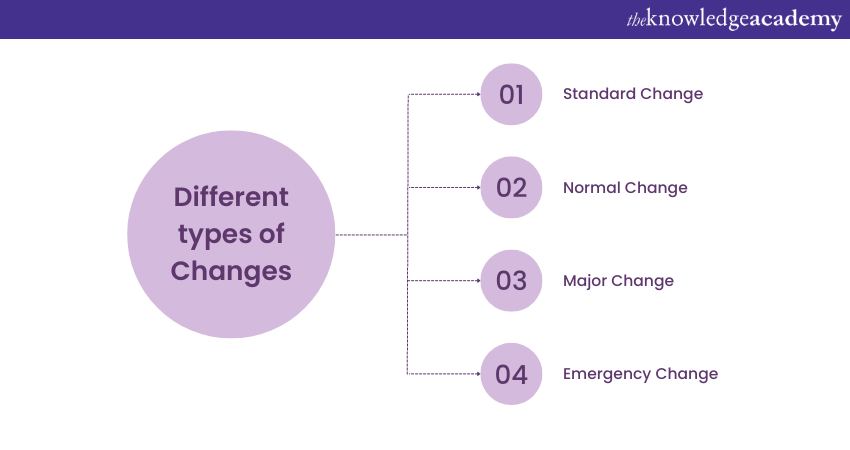
1) Standard Change
A standard change represents routine and low-risk modifications in an organisation's processes or systems. These alterations are well-defined, with established procedures for implementation.
Typically minor in scope, they require minimal approvals due to their repetitive nature. Common examples include software updates, hardware replacements, and user account creations.
2) Normal Change
Normal Changes encompass alterations that are more substantial than Standard Changes but still manageable in terms of risk. They involve moderate complexity and require a formal review and approval process. These Changes demand careful planning, impact assessment, and coordination among different departments or teams.
3) Major Change
Major Changes denote substantial transformations that influence multiple dimensions of an organisation. These shifts have a significant impact and necessitate extensive assessment, planning, and stakeholder engagement.
The intricacy of these changes calls for a structured Change Management approach, often requiring a dedicated change board for approval processes.
Major Changes may involve strategic realignments, organisational restructuring, or comprehensive technological updates. Effective communication and thorough planning are crucial to minimise risks and enhance the positive effects of such fundamental changes.
4) Emergency Change
Emergency Changes are rapid-response modifications enacted to address critical situations, such as system failures or security breaches. Characterised by urgency, they aim to swiftly contain and rectify the issues at hand. While the approval process might be expedited, documentation remains essential to ensure accountability and future reference.
Despite the urgency, Emergency Changes still require effective communication to keep stakeholders informed. The goal is to restore operational normality promptly while learning from the incident to prevent similar emergencies in the future.
Gain an understanding of the important concepts, principles, and processes of ITIL Change Management with our ITIL® 4 Foundation Certification Courses today!
ITIL Change Management process
Now, let’s investigate what is the ITIL Change Management process. This encompasses a series of steps and activities that enable organisations to handle changes within their IT environments effectively. Let's explore the stages of the process:
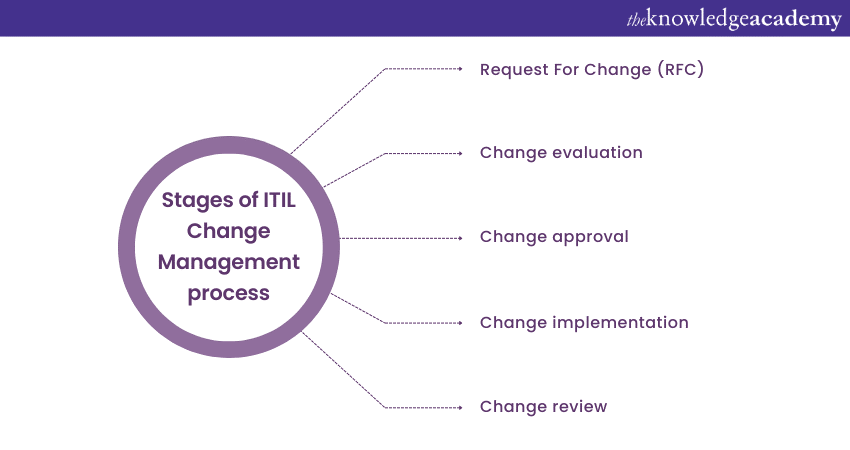
1) Request For Change (RFC)
The Change Management process begins with the submission of a Request for Change (RFC). An RFC is a formal document that captures the details of the proposed change, including its description, purpose, scope, and potential impact. The RFC is the primary communication channel between those requesting the change and the Change Management team.
2) Change evaluation
After receiving an RFC, the Change Management team evaluates the proposed change. This evaluation involves assessing the potential risks, impact on services, resource requirements, and alignment with business objectives. The team considers factors such as technical feasibility, cost implications, and compliance with regulatory requirements.
During the evaluation phase, the team may collaborate with other stakeholders, such as the Change Advisory Board (CAB), to gather additional insights and expertise. The goal is to decide whether the change should proceed or require further analysis and refinement.
3) Change approval
Once the change has been thoroughly evaluated, the team for managing the change, seeks approval from the appropriate stakeholders. This typically involves presenting the proposed change and the evaluation findings and recommendations to the CAB or other relevant decision-making bodies.
The CAB reviews the proposed change in light of business priorities, operational impacts, resource availability, and potential risks. Based on this evaluation, the CAB approves or rejects the change. The decision is communicated back to the team that manages the change and the requester of the change.
4) Change implementation
The Change Management team proceeds with the implementation phase if the change is approved. This stage involves planning the necessary activities, coordinating resources, and executing the change in a controlled manner.
The implementation plan may include scheduling downtime, testing and validation, coordinating with stakeholders, and ensuring proper documentation and communication.
During the implementation phase, the team that manages change closely monitors the progress of the change, addressing any unforeseen issues or risks that may arise. The team also ensures that the change is executed as planned, adhering to established guidelines and minimising disruptions to IT services.
5) Change review
After the change has been implemented, a post-implementation review takes place. This review evaluates the effectiveness of the change, its impact on services, and whether the desired outcomes have been achieved. The Change Management team gathers feedback from relevant stakeholders and assesses lessons learned from the change process.
The insights gained from the post-implementation review are valuable for continuous improvement. They inform future activities for managing change, refine processes, identify areas for enhancement, and ensure that changes are implemented more effectively.
By following the process of Change Management in ITIL - Request for Change (RFC), Change Evaluation, Change Approval, Change Implementation, and Change Review - organisations can systematically manage changes, maintain control, and minimise risks associated with modifications to their IT environments.
Change Management features
It’s time to look at some of the ITIL Change Management features that you must understand to implement this framework:
1) Change creation and logging
Creating and logging organisational changes involves systematically recording proposed alterations and detailing their purpose, scope, and expected impacts. This clear record supports effective Change Management by promoting transparent communication, aiding progress tracking, and establishing accountabilities. Proper logging ensures changes are well-documented from inception, serving as a reference for evaluations, approvals, and implementation.
2) Change planning and evaluation
Change Management relies on robust planning and evaluation. Organisations meticulously outline resources, timelines, and actions during planning, while evaluation assesses risks, benefits, and alignment with strategic goals. This thorough examination safeguards against disruptions, providing insights for informed decisions, adaptive strategies, and proactive issue resolution during implementation.
3) Change approval
Change approval is a crucial step involving stakeholder scrutiny and board approval. Presenting a compelling business case with rationale, expected outcomes, and alignment with goals is vital. Effective communication gains consensus.
Approval guarantees alignment with strategic vision, optimal resource allocation, and a structured, accountable approach to change, allowing only high-benefit, low-risk changes to proceed.
4) Coordinating change implementation
Streamlining approved changes requires adept coordination. This involves assigning tasks, allocating resources, and aligning teams for a smooth transition. Clear communication is vital to managing expectations and addressing issues promptly. Effective coordination minimises disruption, ensures adherence to the plan, and maximises successful change implementation, maintaining operational continuity.
5) Change review and closure
Change review and closure mark the culmination of the Change Management process. After implementation, organisations assess whether the change achieved its intended outcomes and whether any adjustments are required. This involves comparing actual results against initial expectations, analysing the effectiveness of the change, and identifying areas for improvement.
The review phase informs decisions regarding whether the change is considered successful and can be formally closed, or whether further refinements are needed. By actively reflecting on the change's impact and lessons learned, organisations enhance their ability to adapt and refine their change management strategies in the future.
6) Change workflows
Change workflows provide a structured framework for managing the entire lifecycle of a change. These predefined sequences of steps guide change requests from initiation to closure. Workflows ensure consistency, transparency, and accountability by establishing a standardised process for evaluating, approving, and implementing changes.
Benefits of ITIL Change Management
Implementing ITIL Change Management offers numerous benefits for organisations seeking to effectively manage changes within their IT environments. Let's explore some of the key benefits:
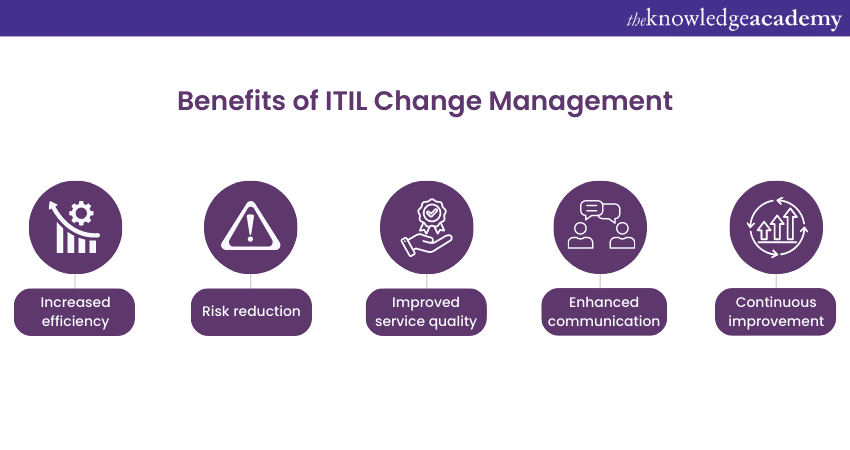
1) Increased efficiency
One of the primary benefits of Change Management in ITIL is improved efficiency in managing changes. By establishing a structured and standardised process for managing change, organisations can streamline the handling of changes, reducing the time and effort required for evaluation, planning, and implementation. This increased efficiency enables IT teams to respond promptly to change requests, minimising delays and maximising productivity.
2) Risk reduction
Change Management in ITIL is crucial in mitigating risks associated with changes. Organisations can proactively identify and address potential issues by evaluating the potential impact and assessing the risks before implementing changes.This proactive approach helps prevent service disruptions, minimise system failures, and reduce the likelihood of security breaches.
3) Improved service quality
Effective Change Management in ITIL contributes to improved service quality. By adhering to a standardised change process, organisations can implement changes with minimal disruption to critical services. This results in enhanced stability, reliability, and availability of IT services, leading to increased customer satisfaction.
4) Enhanced communication
Implementing Change Management in ITIL involves constructive communication and cooperation between the relevant parties. Companies can improve transparency by demonstrating collaboration between IT teams, business units and decision makers in managing change and ensuring that all people are aware and equipped to deal with the changes.
This teamwork benefited the process by enabling better decision-making, reduced cross-misunderstandings, and made it possible to evaluate and appraise the consequences and risks of alternatives.
5) Continuous improvement
ITIL Change Management upholds a culture of continuous improvement within organisations. From post-implementation reviews and getting feedback, organisations locate the areas where they can improve themselves, learn from the past, and polish their processes of Change Management. Through this ongoing process, organisations are able to develop competencies in managing change, respond to changing requirements, and continuously gain efficiency in implementing change effectively.
Best practices for ITIL Change Management
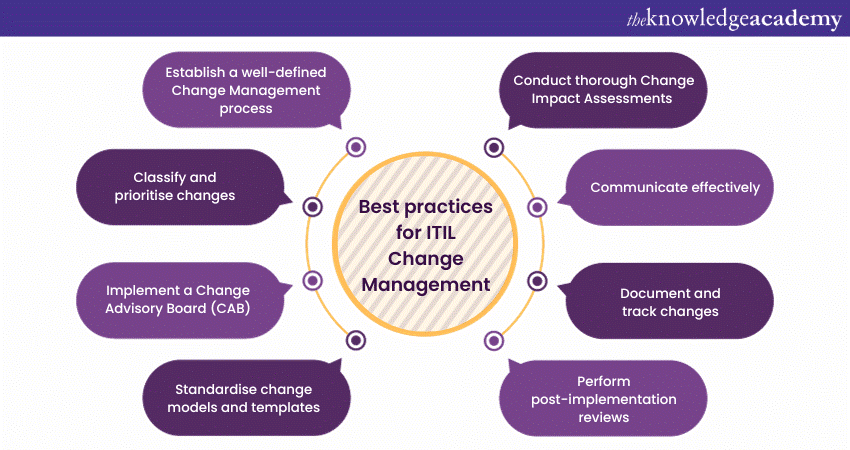
Implementing best practices for Change Management in ITIL can greatly enhance the effectiveness and success of the process within an organisation. Here are some of the effective practices to consider:
a) Establish a well-defined Change Management process: A crucial best practice is establishing an effective process of managing change tailored to the organisation's needs. This process should outline the steps, roles, and responsibilities of managing changes. All stakeholders should document, communicate, and understand it, ensuring consistency and clarity throughout the Change Management lifecycle.
b) Classify and prioritise changes: To effectively manage changes, it is essential to classify and prioritise them based on their impact and urgency. This classification allows organisations to allocate appropriate resources, prioritise changes based on business needs, and focus on high-priority changes that require immediate attention. Common change classification categories include emergency, standard, and normal changes.
c) Implement a Change Advisory Board (CAB): A recommended best practice is establishing a CAB with representatives from various teams and stakeholders. The CAB provides expertise, diverse perspectives, and informed decision-making during the change evaluation and approval. It ensures that changes align with business objectives, are thoroughly evaluated, and receive approvals before implementation.
d) Standardise change models and templates: Developing and utilising standardised change models and templates can significantly streamline the process of managing change. These models provide predefined procedures, workflows, and guidelines for common changes. By using standardised templates, organisations can ensure consistency, reduce errors, and save time when planning and executing changes.
e) Conduct thorough Change Impact Assessments (CIA): Performing comprehensive change impact assessments is critical to understanding the potential consequences of proposed changes. It evaluates the impact on IT services, infrastructure, systems, processes, and stakeholders. This assessment helps identify potential risks, dependencies, and necessary mitigations. Thus, organisations can make informed decisions about change approvals and implementation strategies.
f) Communicate effectively: Effective communication is vital throughout the Change Management process. Organisations should establish clear communication channels to inform stakeholders about upcoming changes, their impact, and any necessary actions or precautions. Regular updates, status reports, and notifications help ensure that everyone involved knows about the changes and their implications, promoting transparency and minimising disruptions.
g) Document and track changes: Maintaining accurate and comprehensive documentation is essential for successful Change Management. Organisations should document all changes, including their rationale, implementation details, and results. This documentation is a historical record, aids future decision-making, and supports audits or compliance requirements. Additionally, organisations should establish a system to track and monitor changes throughout their lifecycle, ensuring visibility and accountability.
h) Perform post-implementation reviews: Conducting post-implementation reviews after implemented changes is a valuable best practice. These reviews help assess the effectiveness and outcomes of the changes, identify lessons learned, and identify areas for improvement. By gathering feedback and evaluating the success of changes, organisations can continuously enhance their Change Management processes and increase overall efficiency.
Equip yourself with the knowledge to excel in managing changes within your IT environment – register for our ITIL® Certification Training now!
Common challenges in ITIL Change Management
While ITIL Change Management brings numerous benefits, implementing and maintaining an effective process for managing change can pose various challenges. Here are some common challenges of implementing the process:
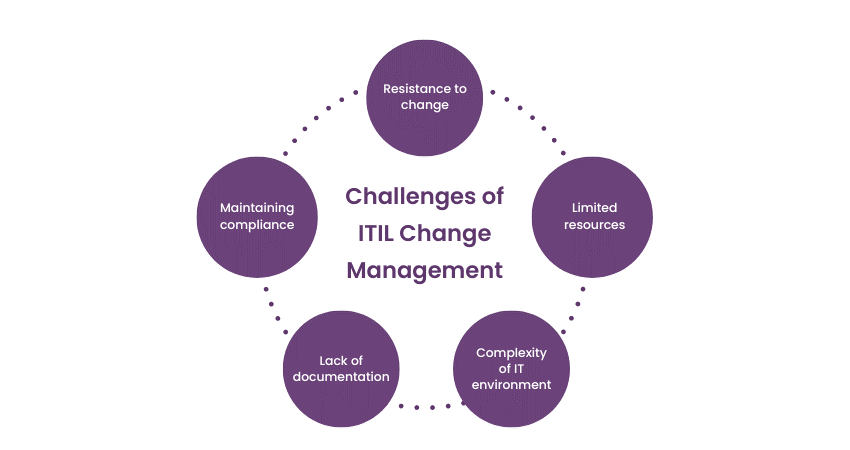
1) Resistance to change: People within an organisation may resist changes due to fear of the unknown, concerns about disruptions to their work, or a lack of understanding of the benefits of change. Overcoming resistance requires effective communication and clear explanations of the reasons for change and its positive impact.
2) Limited resources: Limited resources, such as budget constraints, inadequate staffing, or time constraints, can hinder the effective implementation of ITIL Change Management.
More resources may delay change evaluation, approval processes, or the inability to allocate dedicated personnel for change implementation. Organisations should strive to give appropriate resources and prioritise change initiatives based on business needs and available capacities.
3) Complexity of IT environment: Modern IT environments are often complex and interconnected, with numerous systems, applications, and dependencies. Managing changes in such complex environments can be challenging.
Understanding the relationships and dependencies between different components becomes crucial to ensure that changes do not inadvertently impact other services or systems. Organisations should invest in comprehensive configuration management and mapping to mitigate this challenge.
4) Lack of documentation: Inadequate documentation and knowledge management practices can impede effective Change Management. When documentation needs to be completed or updated, it becomes easier to accurately evaluate the impact of proposed changes. Establishing robust documentation and knowledge management processes helps address this challenge and supports informed decision-making.
5) Maintaining compliance: Organisations operating in regulated industries face additional challenges in ITIL Change Management. Compliance with industry-specific regulations, security standards, and legal requirements necessitates careful planning and documentation of changes. Follow compliance requirements to avoid serious consequences.
Conclusion
ITIL Change Management enables increased efficiency by streamlining the handling of changes, reducing delays, and maximising productivity. We hope this blog has enhanced your understanding of managing change in ITIL, the process and benefits of implementing it, and more.
Wish to become a certified ITIL 4 Strategist.- sign up for our ITIL® 4 Strategist: Direct, Plan And Improve DPI Training now!
Frequently Asked Questions

To excel as an ITIL Transition Manager, master ITIL frameworks, gain hands-on experience, cultivate strong communication skills, and stay abreast of industry trends. Pursue relevant certifications, build a robust network, and demonstrate a proactive approach to managing transitions.

Succeeding in an ITIL Change Management leadership role requires honing skills in strategic planning, communication, team collaboration, and problem-solving. Prioritise adaptability, customer focus, and continuous improvement. Acquire ITIL certifications to showcase expertise and stay at the forefront of best practices.

The Knowledge Academy enhances global learning with a vast selection of over 30,000 online courses, accessible in more than 490 locations across 220 countries. This expansive reach ensures accessibility and convenience for learners worldwide.
Our diverse Online Course Catalogue covers 17 essential categories, complemented by a wealth of free educational Online Resources. These resources include up-to-date News, informative Blogs, tutorial videos, interactive webinars, and collections of interview questions. Furthermore, professionals looking for personalised education can take advantage of TKA's customisable Course Bundles, crafted to enrich and optimise the learning journey.

The Knowledge Academy's Knowledge Pass, a flexible prepaid voucher system, offers the freedom to enrol in courses over a 12-month period. Start your limitless learning adventure with us and embrace education that knows no bounds.

Discover an array of ITIL Certification Courses at The Knowledge Academy, featuring specialised training in ITIL 4 Foundation, Support CDS, and High velocity IT Training. Designed for different skill levels, our courses provide the necessary technical expertise to meet ITIL Incident Management.
Whether you're starting out or looking to upgrade your skills, immerse yourself in our IT Service Management Blogs for further understanding and expertise. Embark on a journey with us to elevate your ITIL Certification proficiency!
Upcoming IT Service Management Resources Batches & Dates
Date
 ITIL® 4 Foundation Certification Course
ITIL® 4 Foundation Certification Course
Wed 1st May 2024
Sat 4th May 2024
Tue 7th May 2024
Thu 9th May 2024
Mon 13th May 2024
Wed 15th May 2024
Sat 18th May 2024
Mon 20th May 2024
Wed 22nd May 2024
Tue 28th May 2024
Thu 30th May 2024
Mon 3rd Jun 2024
Wed 5th Jun 2024
Mon 10th Jun 2024
Wed 12th Jun 2024
Sat 15th Jun 2024
Mon 17th Jun 2024
Wed 19th Jun 2024
Mon 24th Jun 2024
Wed 26th Jun 2024
Sat 29th Jun 2024
Mon 1st Jul 2024
Wed 3rd Jul 2024
Mon 8th Jul 2024
Wed 10th Jul 2024
Sat 13th Jul 2024
Mon 15th Jul 2024
Wed 17th Jul 2024
Mon 22nd Jul 2024
Wed 24th Jul 2024
Sat 27th Jul 2024
Mon 29th Jul 2024
Wed 31st Jul 2024
Mon 5th Aug 2024
Wed 7th Aug 2024
Sat 10th Aug 2024
Mon 12th Aug 2024
Wed 14th Aug 2024
Mon 19th Aug 2024
Wed 21st Aug 2024
Sat 24th Aug 2024
Tue 27th Aug 2024
Thu 29th Aug 2024
Mon 2nd Sep 2024
Wed 4th Sep 2024
Sat 7th Sep 2024
Mon 9th Sep 2024
Wed 11th Sep 2024
Mon 16th Sep 2024
Wed 18th Sep 2024
Sat 21st Sep 2024
Mon 23rd Sep 2024
Wed 25th Sep 2024
Mon 30th Sep 2024
Wed 2nd Oct 2024
Sat 5th Oct 2024
Mon 7th Oct 2024
Wed 9th Oct 2024
Mon 14th Oct 2024
Wed 16th Oct 2024
Sat 19th Oct 2024
Mon 21st Oct 2024
Wed 23rd Oct 2024
Mon 28th Oct 2024
Wed 30th Oct 2024
Sat 2nd Nov 2024
Mon 4th Nov 2024
Wed 6th Nov 2024
Mon 11th Nov 2024
Wed 13th Nov 2024
Sat 16th Nov 2024
Mon 18th Nov 2024
Wed 20th Nov 2024
Mon 25th Nov 2024
Wed 27th Nov 2024
Sat 30th Nov 2024
Mon 2nd Dec 2024
Wed 4th Dec 2024
Mon 9th Dec 2024
Wed 11th Dec 2024
Sat 14th Dec 2024
Mon 16th Dec 2024
Wed 18th Dec 2024







 Top Rated Course
Top Rated Course



 If you wish to make any changes to your course, please
If you wish to make any changes to your course, please


